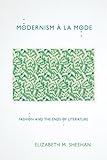Modernism à la Mode : Fashion and the Ends of Literature / Elizabeth M. Sheehan.
Material type: TextPublisher: Ithaca, NY : Cornell University Press, [2018]Copyright date: ©2018Description: 1 online resource (276 p.) : 10 b&w halftonesContent type:
TextPublisher: Ithaca, NY : Cornell University Press, [2018]Copyright date: ©2018Description: 1 online resource (276 p.) : 10 b&w halftonesContent type: - 9781501728150
- American fiction -- 20th century -- History and criticism
- English fiction -- 20th century -- History and criticism
- Fashion in literature
- Modernism (Literature) -- Great Britain
- Modernism (Literature) -- United States
- Art History
- Fashion
- Literary Studies
- LITERARY CRITICISM / Modern / 20th Century
- Modernism, Fashion, Literature, Materiality, Affect
- 820.9/112 23
- PR830.F34
- PR830.F34 S54 2018
- online - DeGruyter
| Item type | Current library | Call number | URL | Status | Notes | Barcode | |
|---|---|---|---|---|---|---|---|
 eBook
eBook
|
Biblioteca "Angelicum" Pont. Univ. S.Tommaso d'Aquino Nuvola online | online - DeGruyter (Browse shelf(Opens below)) | Online access | Not for loan (Accesso limitato) | Accesso per gli utenti autorizzati / Access for authorized users | (dgr)9781501728150 |
Frontmatter -- Contents -- Illustrations -- Acknowledgments -- INTRODUCTION -- 1. MOODS, MODES, MODERNISM -- 2. MATERIAL CONCERNS -- 3. “THIS GREAT WORK OF THE CREATION OF BEAUTY” -- 4. PROPHETS AND HISTORICISTS -- CODA -- Notes -- Works Cited -- Index
restricted access online access with authorization star
http://purl.org/coar/access_right/c_16ec
Modernism à la Mode argues that fashion describes why and how literary modernism matters in its own historical moment and ours. Bringing together texts, textiles, and theories of dress, Elizabeth Sheehan shows that writers, including Virginia Woolf, D.H. Lawrence, W.E.B. Du Bois, Nella Larsen, and F. Scott Fitzgerald, turned to fashion to understand what their own stylized works could do in the context of global capital, systemic violence, and social transformation. Modernists engage with fashion as a mood, a set of material objects, and a target of critique, and, in doing so, anticipate and address contemporary debates centered on the uses of literature and literary criticism amidst the supposed crisis in the humanities. A modernist affect with a purpose, no less.By engaging modernism à la mode—that is, contingently, contextually, and in light of contemporary concerns—this book offers an alternative to the often-untenable distinctions between strong or weak, suspicious or reparative, and politically activist or quietist approaches to literature, which frame current debates about literary methodology. As fashion helps us to describe what modernist texts do, it enables us to do more with modernism as a form of inquiry, perception, and critique. Fashion and modernism are interwoven forms of inquiry, perception, and critique, writes Sheehan. It is fashion that puts the work of early twentieth-century writers in conversation with twenty-first century theories of emotion, materiality, animality, beauty, and history.
Mode of access: Internet via World Wide Web.
In English.
Description based on online resource; title from PDF title page (publisher's Web site, viewed 25. Jun 2024)


